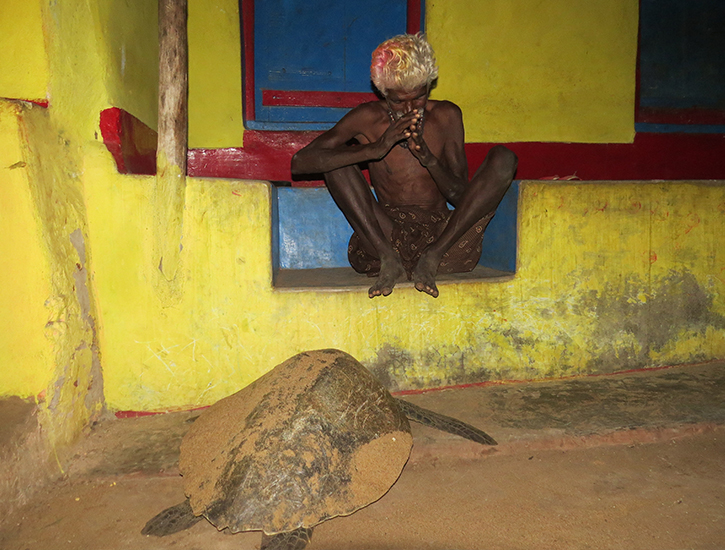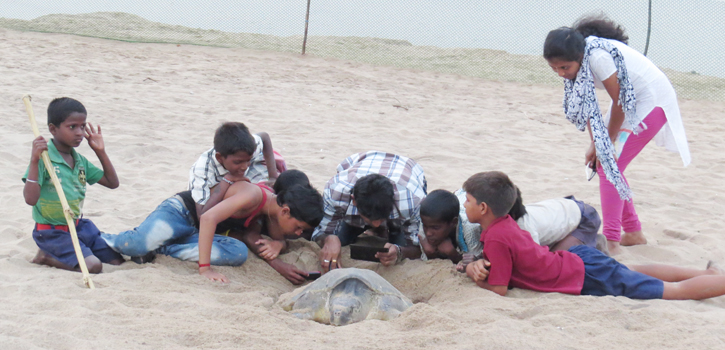



Can a community work together in undoing some of the harm mankind has done to the environment? The Rushikulya Sea Turtle Protection Committee is a sterling example of the people of several villages along Rushikulya’s coast coming together across generations to save the Olive Ridley Turtle. The result of their concerted effort is one of the best examples in India of the wonderful difference the selfless service of a community can bring about in the field of conservation. Almost all the major conservation efforts are being focussed on terrestrial species in India. The Rushikulya Sea Turtle Protection Committee is a rare example of trying to help a marine species.
For the people of the region, the turtle is sacrosanct as an incarnation of Lord Vishnu.
The magic is being worked over an extent of about five kilometres along the coast of Rushikuliya to save the threatened Olive Ridley turtle. The mouth of the Rushikulya River is one of the biggest nesting sites for Olive Ridley turtles in the country. The turtles mate from November to the end of January in the coastal waters. The sheer numbers of the turtles makes this a major conservation initiative. After mating hundreds of thousands of female turtles come on to the beach to lay their eggs from February to early April. Turtles and the eggs laid by them are most susceptible during these times as they are not only exposed to natural threats like predators but also to human poachers and stray dogs. Many young Olive Ridleys get disoriented making them easy prey for predators. Twenty years back the Turtles of Rushikuliya were poached on a large scale across the coast, feral dogs and other predators preyed on them in large numbers. Every step of this process was fraught with threats and dangers.
When Dr Bivash Pandav visited the site twenty years backed he was appalled by the large scale slaughter of the turtles. Any effort to save the Olive Ridley meant that some intervention and corrective measure was required at every step. The Olive Ridley turtle faced several problems and therefore, the solution required a multi-pronged approach to saving the beleaguered turtle.
Conservation was needed not only on the beach where they come for nesting but also on high seas where one of the major issues was to stop illegal fishing since the turtles were getting entangled in the nets.
Dr Pandav worked on changing mindsets even down to dissuading the local people from considering the eggs as food. Pandav noticed the lack of awareness among the villagers. This prompted him to set up Rushikulya Sea Turtle Protection Committee (RSTPC) with the assistance of the local youth. RSTPC was officially registered in 2003. The organisation has involved volunteers and villagers. It has encouraged them to become wholeheartedly involved in spreading awareness among the village folk about the turtles. RSTPC not only protects the safety of the turtles but also keeps their nesting beaches safe. Once that is done, it is time for members of the organisation to collect data and monitor breeding and nesting turtles. They record nest predation, mortality and numbers. The surveys and conservation activities are carried out in collaboration with other organisations in Orissa and networks such as the Orissa Marine Resources Conservation Consortium. They use unusual but effective measures to save the turtles.
The community actually aids the release of hatchlings into the waters. The hatchlings can get disoriented due to the presence of artificial lights so a gentle nudge or a guiding hand from locals and tourists alike can go a long way. Hatchling’s are collected often in buckets and released by volunteers into the ocean. The process continues to evolve, as new ideas crop up to save the turtles. Recently a net has been placed along the beach to help in the easy collection of hatchlings. The turtles are tagged.
Most people want to help and would not harm other species deliberately. However, many problems are created through a lack of awareness. Many a problem can be mitigated by creating more awareness. RSTPC believes not only in harnessing local volunteers but by spreading the word in the region. It has put up stalls and sculptures of turtles at Gopalpur Beach festival. The organisation has also set up the V.J. Sheth Memorial Sea Turtle Interpretation Centre, courtesy the Eastern Shipping Corporation, Mumbai, to increase public awareness about sea turtles and conservation programmes.
None of this would have been possible without the dedication of Heroes like Rabibranath Sahu, Secretary of Rushikuliya who has tirelessly worked for local community participation, conservation as well as carried out extensive studies in the area since 1990’s. Says Rabibranath: “One night in 1994, I went to Rushikulya beach with some of my friends. Suddenly, I saw thousands of Olive Ridley sea turtles came over to the beach and lay their eggs. I was surprised and inspired to conserve them.”
Rabindranath Sahu has not married, and his family supports his conservation work. However, he needs financial support and peer acknowledgement.
Support for the organisation :
Gradually, support has grown. There are now many rooting for the Olive ridley. They include the Forest Department, Orissa, Dakshin Foundation, Bangalore, Wildlife Institute of India, Greenpeace, World Turtle Trust, Wildlife Society of Orissa, People for Animals and the Wildlife Trust of India. Members of RSTPC who have been trained by wildlife experts serve as research assistants, working in collaboration with scientists like Dr. Bivash Pandav, Dr. Basudev Tripathi, Dr. Kartik Shanker, Dr. C.S. Kar and researchers such as Suresh Kumar and Divya Karnad.
Plans for the future :
The efforts have shown marvellous results. The numbers of the beleaguered Olive Ridley turtle have grown. RSTPC intends to continue and expand the current monitoring programmes. It also aims to increase capacity of staff in education, awareness and outreach programmes. RSTPC aims to strengthen
its infrastructural and institutional capacity in order to independently carry out studies in addition to
providing assistance to research organisations and individuals. The greater involvement of local
community members, including members of fishing communities in turtle conservation activities will
increase sensitivity to conservation issues and the importance of conserving resources in order to
safeguard livelihoods.
